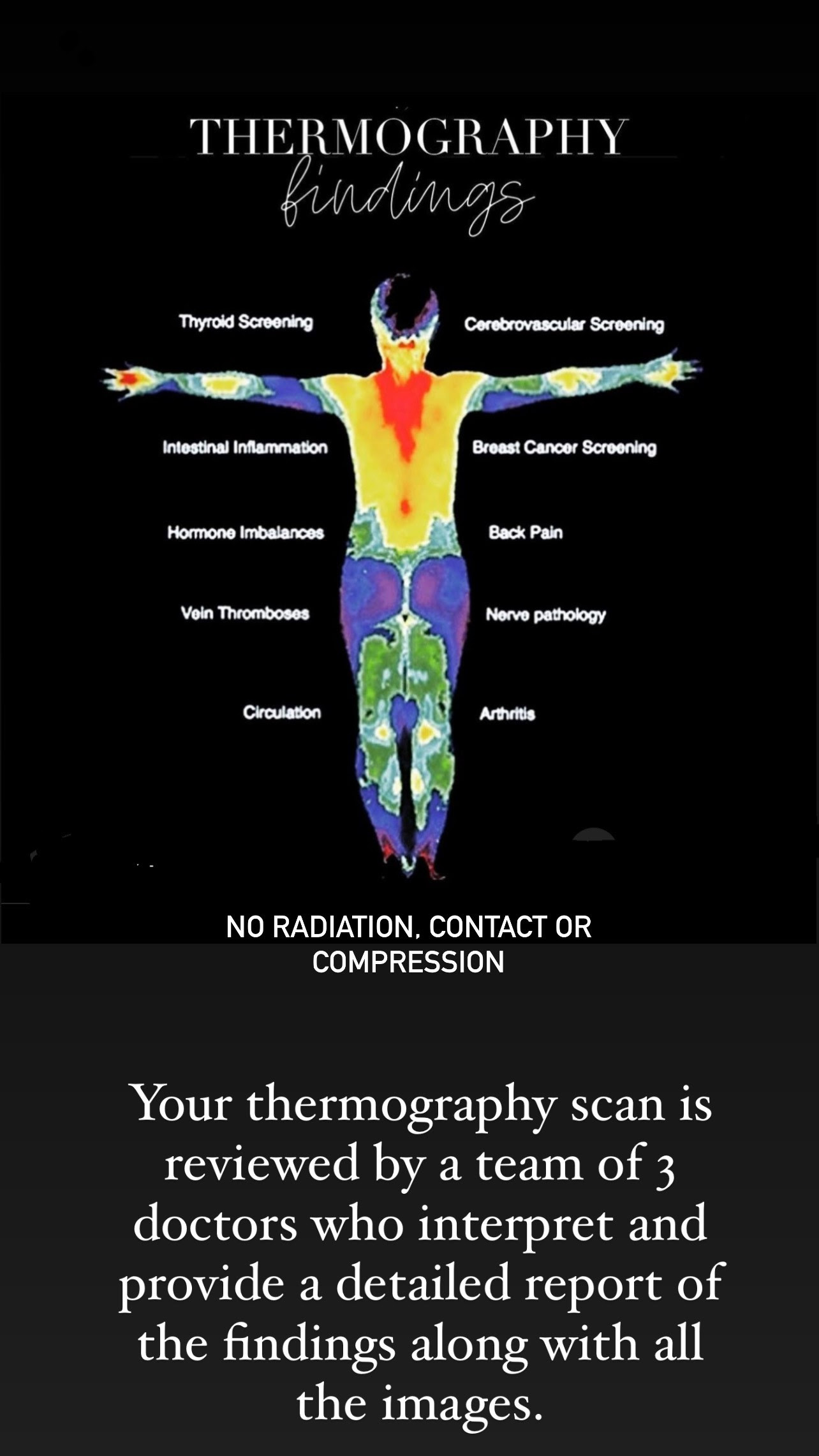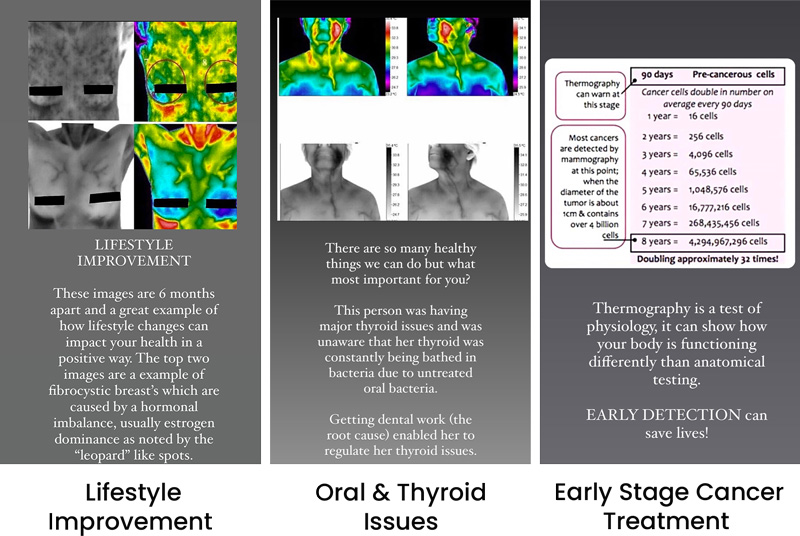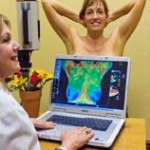Thermography (Thermal Imaging)
Thermal Imaging Appointments Available Tuesday, July 11th
BOOK YOUR APPOINTMENT TODAY! (949) 240-6713
What is thermography?
Thermography assesses blood flow patterns, inflammation and function using very sensitive equipment. It is a non-invasive, non-contact system of recording body temperature by measuring infrared radiation emitted by the body surface. It is a passive, pain free, fast, low cost and sensitive method.
What does thermography detect?
While thermography is most commonly used as a pain, compression and touch-free way to detect breast cancer, it can also be used for early detection of a variety of health issues throughout the body including. but not limited to inflammation, thyroid irregularities, cardiovascular issues, intestinal inflammation, circulation problems, and much more (see images below).


 Nicole has been working in holistic healthcare for 6 years but found her true passion after her mother unexpectedly got Cancer in 2013. She is now dedicated to educating women and men of all ages about the benefits of thermography relating to early disease and cancer detection. Taking charge of your own health is empowering and her passion is to educate people on non-invasive modalities available for them. Since most tumors take years to grow, the earliest indication of pathology is needed to allow for the earliest possible intervention and the least aggressive treatments.
Nicole has been working in holistic healthcare for 6 years but found her true passion after her mother unexpectedly got Cancer in 2013. She is now dedicated to educating women and men of all ages about the benefits of thermography relating to early disease and cancer detection. Taking charge of your own health is empowering and her passion is to educate people on non-invasive modalities available for them. Since most tumors take years to grow, the earliest indication of pathology is needed to allow for the earliest possible intervention and the least aggressive treatments.
Nicole’s hope is that through the collaboration with partnering doctors, thermography will become an integral part of every medical practice for health screenings. She received her CTT certification from the Professional Academy of Clinical Thermology (PACT) and is affiliated with Breast Thermography International (BTI)
BOOK YOUR APPOINTMENT TODAY! (949) 240-6713
Frequently Asked Questions
-
What is Thermography?Medical Thermal Imaging, also known as, Digital Infrared Thermal Imaging (D.I.T.T), or Thermography, is a non-invasive clinical imaging technique for detecting and monitoring a number of diseases and physical injuries by showing any thermal abnormalities present in the body. Thermography uses special infrared-sensitive cameras to digitally record images of the variations in surface temperature of the human body. The recorded images are calling thermograms. These thermograms are then analyzed by a medical doctor who will give diagnosis/prognosis based on the images.
-
Can thermal imaging, or Thermography, serve as an alternative to Mammography?
 Yes, the FDA has approved Thermography as a safe, non-invasive screening technique for breast cancer. There is no touching or compression of the breast during the exam, which only takes minutes to complete. It can also detect signs of cancer up to 10 years earlier without the exposure to X-Ray which is reported to actually increase the risk of cancer.
Yes, the FDA has approved Thermography as a safe, non-invasive screening technique for breast cancer. There is no touching or compression of the breast during the exam, which only takes minutes to complete. It can also detect signs of cancer up to 10 years earlier without the exposure to X-Ray which is reported to actually increase the risk of cancer. -
Can I have a Thermal Breast Evaluation if I’ve had breast surgery (lumpectomy, mastectomy, breast implants/reduction)?Yes. Regardless of previous surgery to the breast tissue, your Thermal Imaging can be performed safely and accurately. In fact, mammography’s effectiveness is limited after such surgeries. There are guidelines as to when the Thermal Evaluation should be performed in relation to surgery.
-
What conditions can Thermography be used to diagnose?Thermography can be used for diagnosis and prognosis of many medical conditions:Altered Ambulatory Kinetics
Altered Biokinetics Brachial Plexus Injuries
Biomechanical Impropriety
Breast Disease
Bursitis
Inflammatory Disease
Int. Carotid Insufficiency
Infectious Disease
Ligament Tear
Lower Motor Neuron Disease
Lumbosacral Plexus Injury
Malingering
Median Nerve Neuropathy
Morton’s Neuroma
Muscle Tear
Musculoigamentous Spasm
Musculoigamentous Spasm
Myofascial Irritation
Nerve Entrapment
Nerve Impingement
Nerve Pressure
Tendonitis
TMJ DysfunctionCarpal Tunnel Syndrome
Compartment Syndrome
Cord Pain/Injury
Deep Vein Thrombosis
Disc Disease
Dystrophy
Facet Syndromes
Ext. Carotid Insufficiency
Nerve Root Irritation
Nerve Impingement
Nerve Stretch Injury
Neuropathy
Neurovascular Compression
Neuralgia
Neuritis
Neuropraxia
Neoplasia
Nutritional Disease
Periodontal Disease
Peripheral Axon Disease
Raynaud’s
Referred Pain Syndrome
Trigeminal Neuroalgia
Trigger PointsGrafts
Heart Disease
Hysteria
Headache Evaluation
Herniated Disc
Herniated Disc Pulposis
Hyperaesthesia
Hyperflexion Injury
Reflex Symp. Dystrophy
Ruptured Disc
Skin Cancer
Somatization Disorders
Soft Tissue Injury
Sprain/Strain
Stroke Screening
Synovitis
Sensory Loss
Sensory Nerve Abnormality
Skin Abnormalities
Somatic Abnormality
Superficial Vascular Disease
Temporal Arteritis
Ulnar Nerve Entrapment
Whiplash end edit
Contact Us
- 3551 Camino Mira Costa Suite CSan Clemente, CA 92672
- (949) 240-6713
- info@o2-wellness.com
- Get Directions
- Send Us A Message

